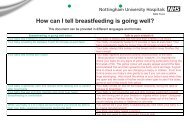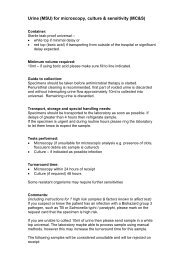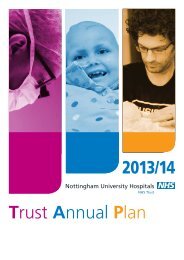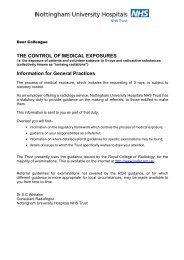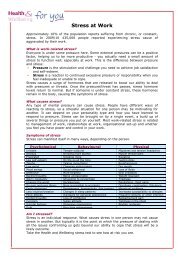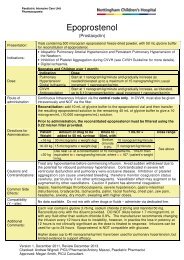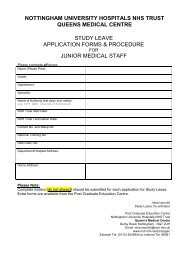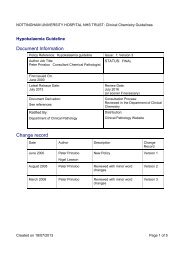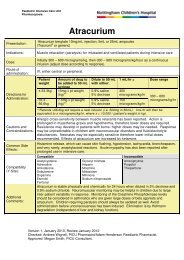Document Information Change record - Nottingham University ...
Document Information Change record - Nottingham University ...
Document Information Change record - Nottingham University ...
Create successful ePaper yourself
Turn your PDF publications into a flip-book with our unique Google optimized e-Paper software.
NOTTINGHAM UNIVERSITY HOSPITAL NHS TRUST: Clinical Chemistry Guidelines<br />
Hyponatraemia Guideline<br />
<strong>Document</strong> <strong>Information</strong><br />
Policy Reference: Hyponatraemia Guideline Issue: 1: Version 3<br />
Author Job Title:<br />
Peter Prinsloo Consultant Chemical Pathologist<br />
STATUS: FINAL<br />
First Issued On:<br />
June 2000<br />
Latest Reissue Date:<br />
March 2008<br />
<strong>Document</strong> Derivation:<br />
See references<br />
Ratified By:<br />
Department of Clinical Pathology<br />
Review Date:<br />
March 2010<br />
(or sooner if necessary)<br />
Consultation Process:<br />
Reviewed in the Department of Clinical<br />
Chemistry<br />
Distribution:<br />
Clinical Pathology Website<br />
<strong>Change</strong> <strong>record</strong><br />
Date Author Description <strong>Change</strong><br />
Record<br />
June 2000<br />
Peter Prinsloo<br />
Nigel Lawson<br />
New Policy Version 1<br />
August 2005 Peter Prinsloo Reviewed with minor word<br />
changes<br />
March 2008 Peter Prinsloo Reviewed with minor word<br />
changes<br />
Version 2<br />
Version 3<br />
Created on 14/03/2008 Page 1 of 4
NOTTINGHAM UNIVERSITY HOSPITAL NHS TRUST: Clinical Chemistry Guidelines<br />
Hyponatraemia Guideline<br />
Definition<br />
Sodium less than 135mmol/L. Hyponatraemia is usually only clinically significant if<br />
sodium concentration is less than 125mmol/L or there is a rapid drop in sodium<br />
concentration (> 20mmol/L in 24 h). Investigate for hyponatraemia if sodium is<br />
persistently less than 130mmo/L.<br />
Symptoms/Signs<br />
<br />
<br />
<br />
<br />
<br />
<br />
<br />
Nausea<br />
Vomiting<br />
Headache<br />
Confusion<br />
Hypotension<br />
Seizures<br />
Coma<br />
Common Causes<br />
<br />
<br />
<br />
<br />
<br />
<br />
<br />
Inappropriate IV fluids e.g. dextrose<br />
Oedematous states e.g. liver failure, congestive cardiac failure, nephrotic<br />
syndrome and myxoedema.<br />
Diuretics<br />
Hyperglycaemia (appropriate osmotic response)<br />
Fluid loss (hypertonic dehydration)<br />
Mineralocorticoid deficiency<br />
SIADH (see below)<br />
Please note this list is not comprehensive and other causes may need to be considered.<br />
Artefacts<br />
<br />
<br />
<br />
Sample taken from drip arm<br />
Gross lipaemia (measure plasma lipids)<br />
Gross hyperproteinaemia (measure total protein)<br />
N.B. Ward-based sodium meters (blood gas analysers) are not affected by lipid or protein.<br />
Created on 14/03/2008 Page 2 of 4
NOTTINGHAM UNIVERSITY HOSPITAL NHS TRUST: Clinical Chemistry Guidelines<br />
Clinical Assessment<br />
Before carrying out extensive investigations clinically assess the patient<br />
• Fluid status- dehydration, euvolaemia, oedema<br />
• Accurate fluid balance charts and weight.<br />
Initial Investigations<br />
Plasma<br />
- Sodium, Potassium, Urea, Creatinine<br />
- Glucose<br />
- Osmolality<br />
- Liver function tests<br />
- Thyroid function tests<br />
Urine (random, no preservative)<br />
- Sodium, Creatinine<br />
- Osmolality<br />
Further Investigations<br />
(If common causes excluded)<br />
In a clinically dehydrated patient<br />
- If the urinary sodium is high (>20mmol/L) then renal loss of sodium is the most<br />
likely cause. Consider adrenocortical insufficiency.<br />
- If the urinary sodium concentration is low (25-30mmol/L) consider SIADH<br />
- If the urinary osmolality is inappropriately high then consider SIADH<br />
Created on 14/03/2008 Page 3 of 4
NOTTINGHAM UNIVERSITY HOSPITAL NHS TRUST: Clinical Chemistry Guidelines<br />
Diagnostic Criteria for Syndrome of Inappropriate ADH (SIADH)<br />
The diagnosis of SIADH is a diagnosis of exclusion.<br />
The following criteria must be met<br />
- Plasma Na < 135mmol/L<br />
- Plasma osmolality < 270mOsmol/kg<br />
- Urine osmolality > 100mOsmol/kg<br />
- Urine Na > 25-30mmol/L<br />
- No clinical evidence of hypovolaemia or oedema/ascites<br />
- Normal adrenal, thyroid, pituitary and renal function<br />
- Not on diuretic therapy<br />
References<br />
1) Sodium. Kumar S, Berl T. The Lancet 1998; 352: 220-229.<br />
2) The Hyponatraemic patient: Practical focus on therapy. Lauriat SM, Berl T. J Am Soc of<br />
Nephrology 1997; 8: 1599-1607.<br />
Disclaimer: These guidelines have been registered with the Trust. However, clinical<br />
guidelines are guidelines only. The interpretation and application of the clinical guidelines will<br />
remain the responsibility of the individual clinician. If in doubt contact a senior colleague or<br />
expert. Caution is advised when using guidelines after the review date.<br />
Created on 14/03/2008 Page 4 of 4



